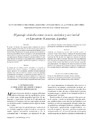Identificador persistente para citar o vincular este elemento:
https://accedacris.ulpgc.es/jspui/handle/10553/58469
| Título: | Paisaje vinícola, turismo y planificación territorial. La experiencia en el caso de Lanzarote (Canarias, España) | Otros títulos: | Landscape of vineyards as touristic and territorial resource in Lanzarote (Canary Islands, Spain) Le paysage du vin comme ressource touristique et territoriale en Lanzarote (Îles Canaries, Espagne) |
Autores/as: | Ramón Ojeda, Antonio A. González Morales, Alejandro Hernández Torres, Santiago |
Clasificación UNESCO: | 54 Geografía 250504 Utilización del terreno 531290 Economía sectorial: turismo |
Palabras clave: | Paisaje del vino Planificación territorial Atractivo turístico Paysage du vin Aménagement du territoire, et al. |
Fecha de publicación: | 2017 | Publicación seriada: | Eria-Revista Cuatrimestral De Geografia | Resumen: | El paisaje vitivinícola y los espacios rurales conforman un atractivo turístico singular y destacado en la isla de Lanzarote, pero también un elemento de valor para las políticas de ordenación del territorio en este ámbito insular. El patrimonio del pasado agrícola y los desarrollos tu- rísticos recientes deben convivir en el espacio y en la memoria local del espacio. En este escenario, la agricultura y el turismo son compatibles y complementarios. El objeto del presente artículo es analizar las cuali- dades turísticas en el paisaje y su tratamiento desde la plani cación del territorio como un ejemplo de coordinación de políticas y estrategias en los espacios insulares. Landscape of vineyards and rural areas form a unique and outstanding touristic resource in the island of Lanzarote, but they are also very important as elements of value for planning of this insular environment. The assets of the agricultural past and recent tourism developments coexist in this space and in the local memory. In this scenario, agriculture and tourism become compatible and complementary. The purpose of this article is to analyze the tourist qualities in the landscape and its treatment from the spatial planning, as an example of policies and strategies coordination in insular spaces. Les paysages viticoles et les espaces ruraux de l’île de Lanzarote constituent un attrait touristique singulier, mais aussi un élément à valoriser au sein des politiques d’aménagement du territoire. Le patrimoine du passé agricole et le développement touristique récent doivent cohabiter dans l’espace et la mémoire locale . Les activités agricoles et touristiques sont compatibles et complémentaires. Cet article analyse les qualités touristiques du paysage insulaire de Lanzarote et leur intégration à l’aménagement en tant qu’exemple de coordination de stratégies territoriales. |
URI: | https://accedacris.ulpgc.es/handle/10553/58469 | ISSN: | 0211-0563 | Fuente: | Ería: Revista cuatrimestral de geografía [ISSN 0211-0563],v. 37 (3), p. 320-334 |
| Colección: | Artículos |
Visitas
152
actualizado el 01-nov-2024
Descargas
179
actualizado el 01-nov-2024
Google ScholarTM
Verifica
Comparte
Exporta metadatos
Los elementos en ULPGC accedaCRIS están protegidos por derechos de autor con todos los derechos reservados, a menos que se indique lo contrario.
